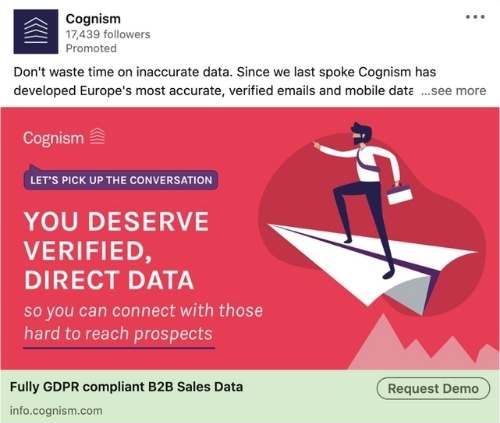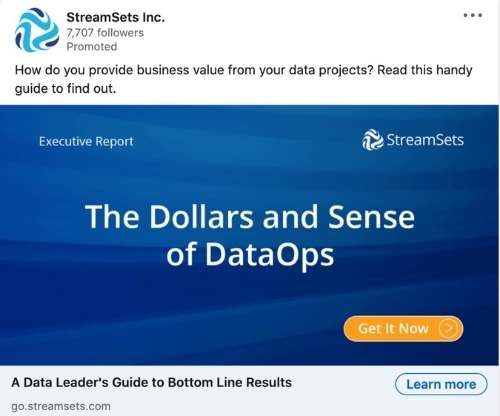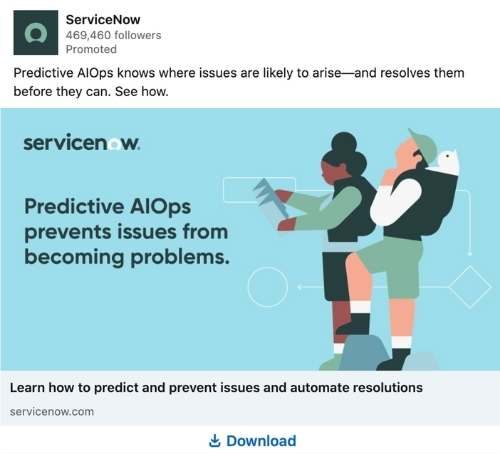This has to be the year of data. It’s no longer enough to talk about it. Instead, we need to use it to drive our content marketing strategy and make intelligent marketing decisions. Social media has democratized content publishing, allowing everyone with an internet connection and decent writing skills to flood the internet with noise.
Social media has also changed how we consume-share-produce and link to content on the internet. Data-driven content marketing is the only way to reach these customers and prospects. The only way!
For CMOs, and brand and content marketers, one of the biggest challenges is determining how to use data-driven content marketing to attract and retain customers. So as we enter the new year, let’s talk about using online research to inform your content marketing strategy.
What is Data-Driven Content Marketing?
Data-driven content marketing is the process of creating content based on insight. It’s an insight backed by defendable data and research. It can be long-form content like an article or blog post or a short-form shareable piece of content on social media channels like an Instagram post, Tweet, or LinkedIn status update.
But there’s a difference between content marketing based on intuition and hope and content marketing built on data. Data-driven content marketing is anchored in real-world customer and prospect insights. This audience data can come from various sources, including surveys, focus groups, customer interviews, social media listening, and web analytics.
Once you have your customer data, the next step is to analyze it to find trends and patterns in the discussion. For example, what is the audience talking about? Are there any keywords, phrases, or buzzwords that are unfamiliar? Again, this data can inform digital marketing strategies beyond content and social media.
What is your target audience searching for? What are their pain points? Once you understand their needs and wants, you can create shareable content that addresses those pain points and uncover your customers’ unmet needs based on what they search for on Google.
Why is Building a Data-Driven Content Marketing Strategy Important?
Data-driven content marketing is not just important. It’s critical. Content marketing strategies informed by data ensure that you can target your content to the right audience at the right time and in the most efficient channel. The result leads to reaching more people on Google, improved customer success, and higher conversion rates. Data is probably the most critical asset in a marketer’s tool kit, yet many ignore it. Why? Big data can be overwhelming. Knowing where to start is hard, and getting lost in the numbers is easy.
But data doesn’t have to be scary. You needn’t be a data scientist to drive your content marketing strategy. Some tools and platforms can help optimize and rank content and improve your search visibility.
Another reason building a data-driven content marketing strategy is vital is that it allows you to measure the performance of the stories you distribute into the marketplace in various paid media channels. For example, you can track how many people viewed, downloaded, shared, or read your content with data. You can also track how many leads or sales were generated due to your content. This information will help you determine which pieces of content are the most successful with your audience and which need improvement.
The bottom line is that data-driven content marketing works. Creating content from real-world customer insights resonates with your target audience and leads to better segmentation and conversion rates. So if you want to succeed in 2023, data-driven content marketing must be a priority.
How Does Data-Driven Content Marketing Strategy Work?
There is no one-size-fits-all answer to this question, as the approach you take will vary depending on your data and the insights you have at your disposal. However, here is a general framework you can use to create data-driven content marketing strategies for your business:
Start with your target audience. Before starting the content creation process, take some time to dissect your audience. Who are they? What do they want? What are their pain points? Once you understand your audience well, you can create content that will resonate with their needs. A good approach is to build buyer personas that align with your brand promise and reflect your audience. Buyer personas are fictional characters representing your ideal customer. It includes demographic information like age, sex, occupation and psychographic information like interests and needs. More advanced buyer persona analyses will include keyword research using SEO tools like SEMrush or Surfer SEO data.
Keyword and topic analysis. Another way to use data is to determine which topics to cover in your content. What are people searching for? What are they talking about on social media? What are the latest trends? Use this information to determine which topics you should address in your content. You can use cluster analysis tools like Netbase Quid or Graphext to cluster larger text data sets. This analysis uses artificial intelligence and NLP to uncover those hidden themes and topics based on the relationships and context of the words.
Use data to determine what type of content to produce. This goes beyond the narrative, topics, and themes important to your customers. Once you know the content they are engaging with, you can use that data and analytics to create and produce the content for that channel. For example, are they interested in case studies? Infographics? Blog posts? Videos? Once you know what type of content your audience wants, you can tailor your content’s production accordingly.
Make sure your content is relevant and timely. You must be prepared to execute your content marketing strategy in real-time in today’s world. Consumers move so fast that marketing teams must think about agile content creation and be prepared to engage in real-time. To be effective, data-driven content must be both relevant and timely. Ensure you monitor current events and address the latest trends in the content channels.
The Anatomy of Short-Form Content Marketing and Storytelling
The only effective way to reach audiences on social media is through short-form content marketing and storytelling. But what do these buzzwords mean?
What is short-form content marketing and storytelling?
Let’s break it down into a few different pieces.
- Short form refers to the format. It’s the combination of a few words coupled with a digital asset. That digital asset could be a still image, animated video, gif, or a 15 to 30-second video.
- Content marketing … well, that’s self-explanatory, but in this context, shareable content on social media drives some action. A click, share, like, comment.
- Storytelling is a narrative of a series of related events, experiences, or message points.
In a nutshell, short-form content marketing and storytelling are telling a related story on a social media channel using the combination of a digital asset and post copy. This is extremely important for any B2B content marketing strategy.
What are the challenges of short-form versus long-form content?
For some, writing long-form content comes easily. Most journalists, writers, and novelists have gone through years of formal education to build up their writing expertise. I would venture to say that most of them were also born with the gift of words. They can articulate a thought or idea using language and stories. Some are better than others, but they are all talented.
The challenge with short-form storytelling is having to articulate those same thoughts and ideas using fewer words and a digital asset. Despite what others may tell you, it’s not easy. Social media content creation is more than just writing a Tweet or status update.
Breaking down the setups and payoffs of short-form digital content
In Hollywood, there is something called a setup and a payoff. In every movie or television show, the larger narrative usually involves a setup and a payoff. The setup is either the challenge or the opportunity. And the payoff is the outcome.
Did the man get the girl? Did the high school football team overcome adversity and win the state championship? Did the cop catch the bad guy?
Even within the story’s larger context, there are usually more minor sub-plots or storylines that also have a setup and payoff.
Think about a series like Criminal Minds or 9-1-1. Each episode has its own confined storyline with a setup and payoff. Even if you watch one episode, you’d be able to understand it. There are also larger setups and payoffs within these television shows; to understand the full narrative, you’d have to binge-watch the entire season to get it.
It would be challenging to start watching a series like The Handmaid’s Tail or Son of Anarchy because each builds off of the previous one.
A setup hints at the action or obstacles later in the story. It plants information and deepens the viewer’s sense of anticipation by providing clues about what’s to come. A setup lays the groundwork by creating user curiosity.
The payoff is the reveal.
Other terms for “payoff” include discoveries, revelations, surprises, epiphanies, twists (sometimes plot twists), or reversals. Everything in the story has been set up and is now fully realized.
In comedy, this is called a punchline. In social media, this is called a well-written social media content creation.
Let me explain.
With short-form digital content, the setup is creative, and the payoff is the post copy.
The creative could be a 15-30 second video clip, an animated video with vector graphics, an animated gif, a photo, a photo with words on it, a PDF document, or anything that will grab the user’s attention. This visual storytelling continues to be a dominant way to influence purchase decisions, according to a Gen Z shopping habits report from eMarketer.
It is meant to pique users’ attention, stop them from scrolling, and spike curiosity. But, of course, the natural behavior is for users to read the post copy. That is the payoff.
The question is: does the combination of the digital asset and post copy tell a story? Will it cause a user to act like a click, a share, or a comment? Is there a proper setup and payoff?
Short-form Content Marketing Examples
Short-form content examples that can be improved. Let’s review this through the lens of a setup and payoff. In this case, the setup is an image of the person flying on a paper plane. The color stands out with the white background. The challenge is that there are a lot of messages in this image. There are 20 words on the image, not including the company logo. And some of the words would be hard to read on a mobile device.

The bottom ad description has even more words with the “request demo” call to action. This is not a terrible piece of content, but it could be improved. In this case, I don’t know what the setup is or what Cognism wants to reveal to me.
When I look at the post copy, there are even more problems. First, I must click “see more” to view the full post copy. The mere action of clicking will deter users from doing so. They want to read the payoff quickly without having to think so much.
The payoff itself is wordy. There’s too much information. A strong payoff is quick, concise, and drives action. When I read this in context with the setup, it does make sense after 15 or 30 seconds of discernment. Unfortunately, 15 to 30 seconds is way too long.
Here’s another example of social media content that can be improved.

The setup of this post is pretty good—a strong headline on the image, a call to action to watch the webinar, and minimal text.
The issue here is with the payoff.
Not only does it require users to click “see more,” but there’s also the issue with hashtags. If the action that Illusive wants me to take is to sign up for the webinar, they’re giving me way too many other options to do something else.
They have added four total hashtags in the post copy, and clicking on a hashtag takes you to the search results page to see other posts with the same hashtag. It’s doubtful that someone will click the back button and then the call to action to sign up for the webinar. Social media best practice is to have only one call to action in every post. In this case, they have four.
Also, the payoff, in general, has way too much text. It looks like a giant blob of words put together with a storyline. In this case, the payoff needs to be a concise and complete story.
As I said, short-form content marketing and storytelling are not easy and take practice.
Good examples of social media content creation. Here are a few examples of brands creating social media content correctly. The setup is simple in this first example with StreamSets Inc. There’s a DataOps report available for download. When I look at the post copy, the payoff tells me why I should download this report–to get value from data projects. Then, they close the payoff with a simple call to action to read the information.

This post from ServiceNow is also an excellent example of social media content creation. The setup is straightforward, with minimal words. They want me to download a report, white paper, or eBook (not sure which one) to learn how predictive AIOps can help me with automation. The payoff is also clear and concise, with a strong CTA.

Short-form storytelling is a skill that marketers need to learn to break through the newsfeed algorithm. People relate to stories, and a strong setup and payoff are essential, especially when marketers are unsure how to get customer attention. This means there must be a very creative setup coupled with an equally as strong payoff, whether short form or long, from digital content strategy.
Equally as important for marketers is to learn how to measure and optimize content marketing performance in real time.
What is the Best Way to Measure Data-Driven Content Marketing?
Everyone measures PESO marketing differently. The best way to measure data-driven content marketing will vary depending on your industry, business goals, and target audience. However, some of the most common ways to measure data-driven content marketing include website traffic, social media engagement, conversion rates, and leads. Here’s a common framework to use for your brand.
Start with your goals. What are you trying to achieve with your data-driven content marketing? Are you looking to increase website traffic? Generate leads? Increase brand awareness? Create engagement? Once you know your goals and document your performance KPIs, you can determine which metrics to track for your campaign.
Use the right tools. There are several different tools you can use to measure data-driven content marketing. For example, Google Analytics is a free tool that allows you to track website traffic and engagement. Hootsuite Insights is another free tool that lets you follow social media engagement. In addition, several paid tools, such as BuzzSumo, allow you to track the most popular posts and content on your channels.
Below are some common KPIs that your company and brand can use to measure the performance of digital marketing campaigns and channels:
- Engagement: Any interaction with your content, including likes, comments, shares, and downloads.
- Impressions: The number of times your content is displayed, regardless of whether or not it resulted in engagement.
- Traffic: The total number of web visitors that go to your site due to a campaign.
- Conversions: The total number of people who take the desired action due to your content and campaigns, such as signing up for a newsletter or buying a product.
- ROI: calculated based on how much revenue your content generates vs. how much you invested in creating it.
- Influencers: The number and quality of influencers that share a piece of content and say something favorable about your brand.
- SEO: The visibility of your blog content and where it will rank in the search engine results pages (SERPs).
The old-school model of content and digital marketing is dead. In the past, marketers created buyer personas, wrote SEO-optimized blog posts or videos, and relied on organic social media to drive website traffic. This hit-or-miss strategy depended heavily on luck and word of mouth. The new data-driven approach has changed everything by providing marketers with an understanding of what customers want before creating anything. Unfortunately, companies still relying solely on traditional content will be left behind in 2022 because this thinking leads to frustration and wasted time/money/effort.
The only way to succeed with data-driven content marketing is to get started. Begin by understanding your audience and their need. Then, use data to determine the content type, the topics to cover, and how relevant and timely your content must be. Finally, track the right metrics using the right tools, and measure the success of your efforts over time.
FAQ
Q: How is content marketing different from a content strategy?
A: A content strategy is a plan that outlines how and where you will create and distribute your content. A content marketing strategy is implementing that plan, including the tactics you will use to achieve your goals.
Q: What are some excellent tools for measuring data-driven content marketing?
A: Google Analytics, Hootsuite Insights, BuzzSumo, and other paid tools are good options for measuring data-driven content marketing.
Q: What are some good metrics to track?
A: Engagement, impressions, traffic, conversions, and ROI are good metrics to track when measuring the success of data-driven content marketing.
Q: How do I know if my data-driven content is successful?
A: You should track your goals before creating content and measure how well your content is helping you achieve those goals. If your goal is to increase website traffic, track website visits or page views. If your goal is to generate leads, then track conversions. There is no one-size-fits-all answer, so you must determine which metrics are most relevant.
